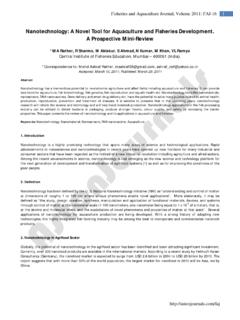Transcription of Development of the genetically improved farmed …
1 Development of the genetically improved farmed tilapia ( gift )Ravelina Recometa-Velasco, Central Luzon State University, Science City of Mu oz, the Philippines and Ponzoni, Fish Breeding and Genetics Group, The WorldFish Center, Penang, MalaysiaPresented byMatthias HalwartFisheries and Aquaculture DepartmentFAO RomeBackground problem identification WorldFish and partners research on Tilapias, which began in late 1970s, indicated that inadequate seed supply and deteriorating performance of the fish in many aquaculture systems in Asia were a major bottleneck for aquaculture In Africa, aquaculture production was in its infancy, and wild stocks of native tilapias were under threat due to habitat degradation, uncontrolled fish transfers and over-exploitationProject planningIn 1987 WorldFish brought together partners from Asia and Africa, as well as international experts to review the status of Tilapiagenetic resources.
2 As an outcome of this meeting a decision was made:To undertake a major research project on genetic improvement of tropical tilapias?Tilapias are farmed in more than 85 have many desirable qualities: stocking density, resistanceto diseases, opportunistic tilapias stocks in the world were of poor genetic improved farmed TilapiaGIFTO bjectives Develop a method applicable to tropical species Develop a faster growing strain Preferably, suitable for low and high input systemsFounder populationsWild: Egypt, Ghana, Kenya, SenegalFarmed: Israel, Singapore,Taiwan PoC,ThailandGIFT ProjectFounder populationsDevelop one strainCross breeding (?)8 x 8 diallel cross = 64 Heterosis lowPure breedingGenotype by EnvironmentLow Experimental designBase populationFive GenerationsGIFTI ndex selectionSelection program.
3 ResultsEvaluation and DisseminationAgro ecological Production systemsCulture systemsBangladesh, China, Philippines, Thailand VietnamDisseminationGIFT has been disseminated to 11 countries in the Asia and Pacific regions and to Brazil and Costa Rica in Latin has captured 69, 36, and 24 per cent of the market in Philippines, Thailand and Vietnam, respectivelyLessons learned The application of quantitative genetics to the genetic improvement of aquatic animals is possible and has beneficial results The technology can be applied to other aquatic animal species, such as carps The effective dissemination of the improved strain poses a major challenge, and skilled human resources have to be assigned to the task to ensure the fish reach the farmer Partnerships among national institutions and scientific ones in developing countries can play a major role in accelerating research Partnership between governmental institutions and the private sector has resulted in a faster and wider dissemination process The gift tilapia experience highlighted the need for an institutionalization of a country specific follow up program once the strain has been transferred and to successConventional Accurate problem identification and sound project design Conduct for enough generations Testing and demonstration of superiority of gift strain Farmers' involvement in evaluation
4 Appropriate structure for dissemination put in place Publicity and promotion of resultsNot so conventional Enthusiasm and commitment of all involved A wise choice of project name GIFTC ould have received greater attention Offer of additional services (feed, management)
















